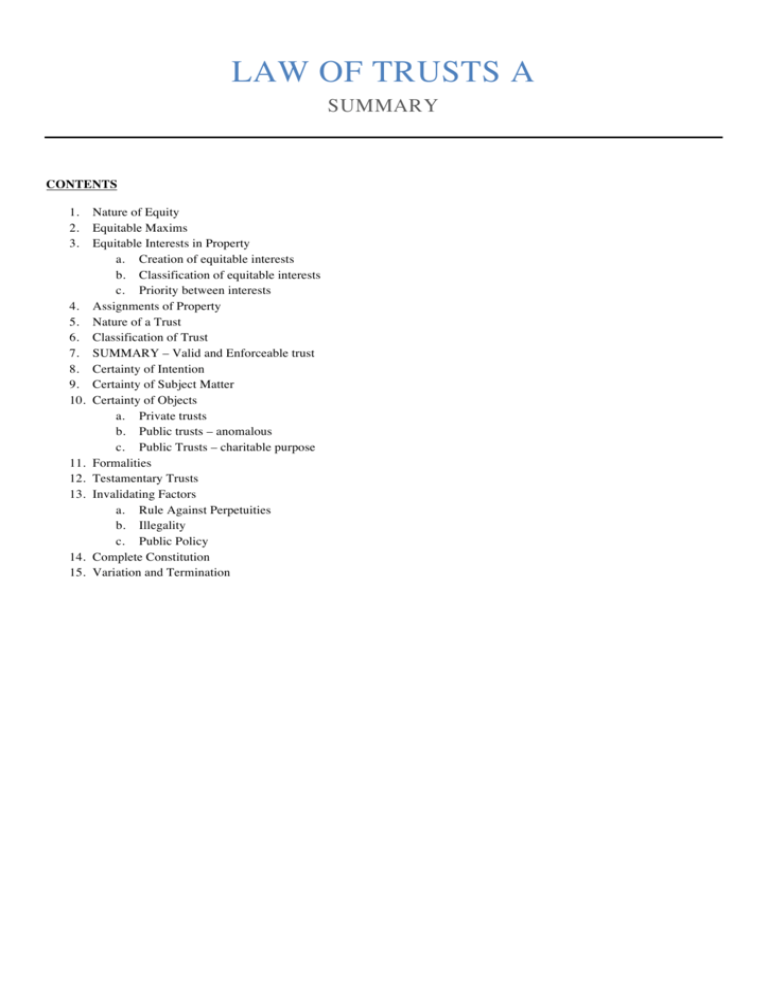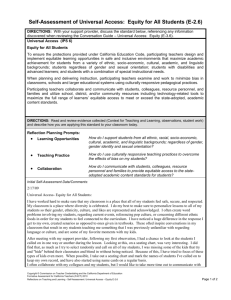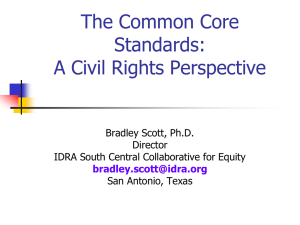LAW OF TRUSTS A
advertisement

LAW OF TRUSTS A SUMMARY CONTENTS 1. 2. 3. 4. 5. 6. 7. 8. 9. 10. 11. 12. 13. 14. 15. Nature of Equity Equitable Maxims Equitable Interests in Property a. Creation of equitable interests b. Classification of equitable interests c. Priority between interests Assignments of Property Nature of a Trust Classification of Trust SUMMARY – Valid and Enforceable trust Certainty of Intention Certainty of Subject Matter Certainty of Objects a. Private trusts b. Public trusts – anomalous c. Public Trusts – charitable purpose Formalities Testamentary Trusts Invalidating Factors a. Rule Against Perpetuities b. Illegality c. Public Policy Complete Constitution Variation and Termination THE NATURE OF EQUITY What is equity? • Broad statements of equitable principle • Not just collection of legal rules/principles. Better understood as a jurisdiction to hear and determine claims, and grant equitable relief • Equity will look at conduct and examine the issue of conscience. “Equity operates on the conscience of the owner of the legal interest…”: Westdeutsche Landsebank v Islington LBC [1996] Development of Equity and Common Law • • • • Developed by Court of Chancery prior to 1873. NOW applied by courts with equitable jurisdiction Equity developed as “font of justice” – could petition King where common law inadequate (needed writ). Considered by Chancellor. Earl of Oxford’s Case [1615] o Dispute b/w Lord Chancellor and Lord CJ over relationship b/w law and equity. CJ claimed common law supreme. o HELD: King ruled in favour of Chancery. This had priority over a common law judgment (set aside common law judgments where against the conscience). Equity does NOT supersede common law; only prevails where in conflict. o ! This rule was re-enacted in Judicature Act 1873 (Imp) s. 25(11). This remains in force (England and Australia). Judicature Act 1873 (Eng.) – what did this do? o (a) Creation of new court to administer both bodies of law " SC of Judicature (CA and HC of Justice) # Common law and equity administered in separate courts. Only way to resolve conflict between two was common injunction, which stopped the common law proceedings. Therefore, JA obviated need for multiplicity of actions. o (b) Abolished common injunction – all claims brought in one court o (c) Abolished Court of Chancery Equity in Australia • • • • A similar separation of common law and equity applied in all states (except NSW – had NSW Act 1823 (UK), which allowed the SC the power and authority to do all things necessary for due execution of equitable jurisdiction). Eventually, judicature system introduced in each. Judicature Act 1876 (Qld) – QLD has the first colony in British Empire to have system of one court administering claims NOTE: These acts unified the administration of law and equity. BUT, the bodies of law remain separate. o “Fusion fallacy” = that JAs united the common law and equity into one bundle of principles: Redgrave v Hurd; Seager v Copydex; Walsh v Londsdale o Australian lawyers reject the fusion fallacy: Murakami v Wiryedi [2010]; Harris v Digital Pulse [2003] Distinction between Common Law and Equity • • CLAIMS o Common Law Claims: Tort and Contract o Equitable Claims: e.g. SP of a contract and Breach of trust # " Equitable claims generally focus on remedies. If damages are adequate, no equitable claim. REMEDIES o Common Law Remedies # Damages # Ejectment o Equitable Remedies – can only be given by court with equitable jurisdiction. # Compensation # Specific Performance # Injunction # Rectification # Account of profits # Declaration EQUITABLE)PRINCIPLES)–)MAXIMS)OF)EQUITY) NOTE: Traditionally, these were fundamental principles on which entire jurisdiction was based. This has been abandoned. These principles illustrate how a court of equity ill reason, but they are not binding; they give guidance. $ Equity follows the law • This is difficult to reconcile with Earl of Oxford’s case. But was developed after that case to reconcile the tensions. • Court of equity will recognise legal rights, titles and interests and has developed its own doctrines by analogy to the common law. • BUT does not blindly follow the law. Will depart if considered necessary for justice (indeed, many remedies are designed to correct defects in the law). While it must follow statutes, will construe them with justice. $ Equity will not assist a volunteer • Equity will not assist a person that has NOT provided consideration " “Equity will not perfect and imperfect gift.” o EXCEPTION: beneficiaries for trusts (they are mostly volunteers). This maxim is not of general application to all cases • Maxim is generally applied in situations where a court of equity will not enforce promises to make gratuitous gifts of property. • Court exercises discretionary justice (i.e. decision to grant remedy entirely discretionary). $ He who seeks equity must do equity • This looks to the future " what will happen if court grants equitable relief? Person must be prepared to fulfil legal and equitable obligations in relation to the matter. Otherwise, unlikely to be granted relief. • This maxim demonstrates the discretionary element of equitable remedies (c.f. common law). Examples: o If plaintiff is guilty of unfairness, or SP would impose hardship on defendant, might not be granted: Hanson v Keating o May not rescind contract is restitutio in integrum not possible o Injunction won’t be granted unless plaintiff is able and willing to carry out obligations undertaken to defendant. $ He who comes to equity must come with clean hands • This looks to the past " what happened before court? A plaintiff must not have engaged in improper conduct (in the legal sense) in relation to the matter before court. • May be prepared to grant relief to plaintiff with improper conduct IF plaintiff will disgorge themselves of the benefit wrongly obtained: Nelson v Nelson (applied in Rohes v Badenach [2000]) • Summary of clean hands doctrine: Black Uhlans Inc. v NSW Crime Commission [2002] 1. Court looks to conduct of applicant, not defendant. 2. Limitation on types of conduct that will be material 3. Conduct must be toward the defendant 4. Must have an immediate and necessary relation to the equity sued for 5. No general rule that relief will be refused where there is impropriety, and allow the loss to lie where it falls 6. Thus even where impropriety, equity may grant relief to ensure wrongdoer does not have benefit of wrongdoing $ Equity looks to intent / substance rather than the form • Underpins equitable doctrine of rectification. • Court is NOT concerned with unnecessary formalities. Will not prevent an order for justice where some kind of technicality. • Formalities: Milroy v Lord (1862) – formalities were expressly contractual; mandatory. Could not be overlooked. • Unnecessary formalities: Raineri v Miles (1980) – court can dispense with to recognise a properly effected transaction. $ Equity looks on that as done which ought to be done • Will grant relief on assumption that legal/equitable obligation has been completed. • Limited to situations where what ought to be done can be done: Walsh v Lonsdale (1882) $ Delay defeats equity " “Equity assists the diligent and not the tardy” $ Equity is equality " equal distribution of profits/losses proportionate to liability $ Equity acts ‘in personam’ • Mainly of historical value – emphasises that equity acts on the conscience. Any breach of equitable order would leave defendant in contempt of Chancellor and liable for imprisonment. Could make an order in relation to subject matter outside the jurisdiction. • E.g. Penn v Lord Baltimore (1750) – foreign land. $ Equity will not suffer a wrong to be without a remedy • This is NOT accurate or operative today. Mainly of historical relevance because courts of equity provided relief of a nature unavailable in common law. Intervention by Chancellor was only on issues of conscience or natural justice. • Courts of equity would be flexible in framing a remedy, having regard to case: Warman International v Dwyer (1982) HCA EQUITABLE)INTERESTS)IN)PROPERTY) What is an equitable interest? • Legal Interest " binds all the world • Equitable Interest " only binds parties to the transaction (i.e. the transferor, and those who can derive title from the transferor who also have notice of that interest) • Statutory recognition of equitable interests in property: o Land Title Act 1994 – section 75: equitable mortgage (created by leaving title certificate with mortgagee) o Civil Proceedings Act 2011 – section 7: equitable estates (proprietary interests, capable of being alienated or transferred) Rights in personam " rights against a person (i.e. personal right) Rights in rem " rights against a thing (i.e. property right) • Characteristics: Exclusivity, Alienability, Enforceable against third parties (whole world) not just a specific individual. • Bundle of rights Starting point of a right in rem is legal; equitable rights in rem are parasitic upon a legal right in rem " P has legal right in rem. P does something sounding in equity. E then has equitable right in personam against P and can bind P in how it deals with its legal rights in rem. E then has this equitable right in personam against the whole world to ensure P deals in this way (except against a bona fide purchaser). E can then enforce equitable right in personam through the legal right in rem. CREATION)OF)EQUITABLE)INTERESTS) • • • In many instances, equity will recognise interests in property where common law refuses to (i.e. for lack of form – e.g. equitable lease) In creating equitable interests, have regard to maxims: o “Equity looks on that as done which ought to be done” o “Equity looks to substance/intent not to form” E.g. Walsh v Lonsdale: Pending a decree of SP (of a lease), a lease agreement can give rise to equitable relationship of landlord and tenant. Creation by implication • • • Creation of an interest in equity where no agreement between parties. That is, interest is premised on existence of certain set of facts. Examples: o A) Vendor’s equitable lien: Hewett v Court (1983) HCA # Implied from circumstance where purchaser of land took transfer of legal estate without paying whole purchase price. # A remedy invented by equity, existing regardless of the parties’ intention. Designed to protect against inequitable loss. o B) Purchaser of land # Where purchaser has paid consideration, and contract is capable of SP, vendor becomes constructive trustee for purchaser (i.e. purchaser is equitable owner): Lysaght v Edwards (1876) UK # This restrains the vendor from dealing with the land contrary to purchaser’s interests: Bunny Industries v FSW # Principal right of the purchaser is to obtain SP of the contract. This is a proprietary right in the subject matter of the contract. Equity only extends to contracts where SP not available and damages inadequate. KDLE Pty Ltd v Commissioner of Stamp Duties (1984) HCA o “The moment you have a valid contract for sale, the vendor becomes in equity a trustee for the purchaser of the estate sold”. # I.e. beneficial ownership passes at the time of execution o Endorsed authority in Lysaght. o Consequences? # Beneficial ownership passes to purchaser # Vendor has right to purchase money # Vendor has charge over estate for security money # Vendor has right to retain possession until payment (in the absence of contractual agreement otherwise) CLASSIFICATION)OF)EQUITABLE)INTERESTS) Why do we classify equitable interests? • Relevant to determining whether particular remedy will be awarded • Relevant to determining whether interest is merely personal, or can be assigned/transferred • In assessing true quality of an equitable interest, must consider what rights (if any) the claimant has in relation to the property, said to be the subject matter of the equity " no clear dividing line between equitable interest in property and ‘mere equity’ EQUITABLE INTERESTS 1. 2. 3. Equitable Proprietary Interest / Equitable Estate Mere Equity Personal Equity 1. EQUITABLE PROPRIETARY INTEREST An interest recognised by a court having equitable jurisdiction, which is proprietary in nature… • • • • Equitable right in rem ! proprietary right Holder of a proprietary interest can be exercise that interest directly against the property in question. o Therefore property subject to the interest can be subject to an in rem remedy (i.e. right to exclude others, transfer the property, grant others rights etc.) o Rights? Sell, transfer, divide etc. Examples: o A) Interest of a beneficiary under a fixed trust (**most significant equitable estate) # Trustee has legal title, but beneficiary (fixed trust) has interest in those assets # This right is still subject to the rights of the trustee, but not simply chose in action (it is a proprietary interest) o B) Equitable mortgage # Where legal owner of property constituting security enters into some arrangement demonstrating binding intention to create security in favour of mortgagee (but doesn’t confer legal title in the subject matter) o C) Interest of a partner in the assets of a partnership Duality of interests? o There is NOT always a legal and equitable estate in all property. Sometimes, ‘equity’ will not consist of any interest in identifiable property, but merely personal rights. o Livingstone v Commissioner for Stamp Duties [1965] (UK) # Viscount Radcliffe (PC): “It is a fallacy to say that for all purposes, and at every moment of time, the law requires the separate existence of two kinds of estate or interest in property, legal and equitable.” # During the process of administration of an estate, beneficiaries do NOT have a proprietary interest in the estate. They have a right to enforce the due administration of the estate (i.e. chose in action). 2. MERE EQUITY The right to seek equitable remedy to acquire a proprietary interest… • • • • • Holder of a mere equity does NOT have a proprietary interest; only right is to apply to court of equity for some remedy, which, if granted, may give rise to some property rights. BUT the holder of a mere equity can transfer that interest. Can be defeated by bona fide purchaser and by an equitable estate. Examples: o Right to seek equitable relief to set aside transfer relating to property obtained through unconscionable behaviour. o Beneficiary under a will with a claim they have the right to transfer property out of estate. o Right to seek rectification for mistake (e.g. defective equitable mortgage, wrongful sale by morgagee) Latec Investments v Hotel Terrigal (1965) HCA o HT held mere equity – right to redemption (due to unconscionable conduct of Latec Investments). o MLC held equitable estate – equitable mortgage (also innocent third party, for value, without notice of prior equity) o MLC’s interest prevailed over mere equity. 3. PERSONAL EQUITY The right exercisable only by a particular person to seek equitable relief… • • • Bare right in personam " No proprietary interest, and cannot lead the holder to acquire any proprietary right. Personal right is NOT assignable. Examples: o Right to rescind contract for misrepresentation, only available to party to whom original misrepresentation was made: Gross v Lewis Hillman Ltd o Beneficiary under discretionary trust – no proprietary interest in the assets, only mere expectancy that power will be exercised in the object’s favour (Kennon v Spry (2008)). # Right in equity to enforce due administration of trust # Right to require trustee to exercise its discretion bona fide # Right to obtain information about the trust from the trustee: Spellson v George o Residual beneficiary in an un-administered estate – no proprietary interest in the assets. Right to compel due administration of the trust: Livingston v Commissioner for Stamp Duties







